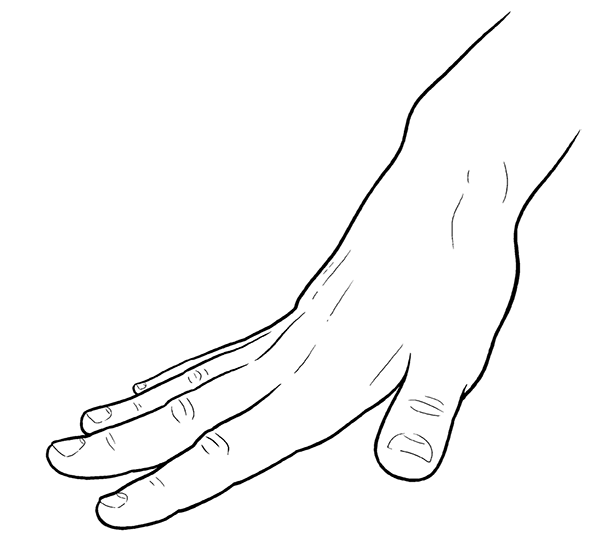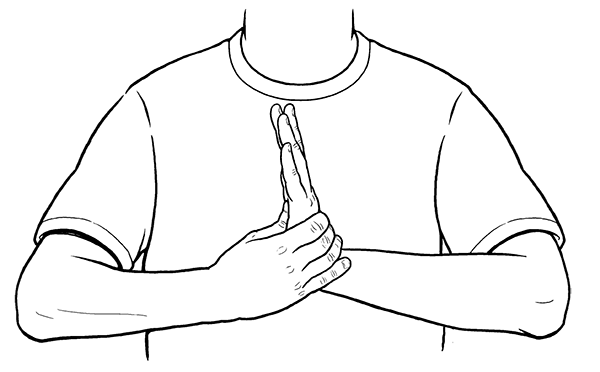In this age of ubiquitous computer keyboards, used both at work and at home, and gaming consoles used extensively for recreation, more people than ever suffer from various repetitive stress injuries, tendinitis, carpal tunnel syndrome, and ulnar nerve damage. Many also simultaneously suffer neck, shoulder, and upper back pain from hunching in front of a computer monitor, holding their hands, wrists, elbows, and shoulders tight in unnatural positions, often unconsciously, for hours at a time. Of course, there are many other causes of hand and arm discomfort—sports-related and other injuries, arthritis, musician’s overuse and postural complaints, and so on—but computer-related problems cut across almost all walks of life and are particularly prevalent today. No matter what the cause, these exercises are of tremendous help in preventing and reversing such conditions, and many can be done during a short five- or ten-minute break while still sitting at your desk.
This is a good warm-up exercise for all the finger and hand exercises that follow.
Purpose
Physical: This exercise involves actively using the muscles in your hands to mobilize your finger and hand joints. It draws more blood into your hands and fingers, and because the involved muscles also attach in the upper forearm, these benefits will occur throughout your forearms too. Blood always brings nutrition, oxygen, and qi in and helps remove local toxic accumulations should any be present. It also helps lubricate the joints and muscles, relaxing those which may be stiff and achy from relative inactivity or overuse, effectively “dried out” from reduced blood flow or inflammation. Conversely, in some people blood and other body fluids may pool, creating a swelling. The activity of this exercise will help pump out the pooled fluids, and over time it will strengthen the muscles so that whatever your finger, hand, and forearm concerns may be, they will improve and have a reduced likelihood of returning.
Energetic: Stimulates all the Five Phase points (Jing Well, Ying Spring, Shu Stream, Jing River, and He Sea) to varying degrees.
The Hand Jing Well points are stimulated indirectly, as blood, moved by the physical aspect of the exercise, brings more qi to the tips of the fingers where the Well points are located. The Jing Well points have an invigorating effect on the mind, and so this practice may help to improve your focus throughout the course of your practice session and into the rest of the day. Mental functioning is additionally stimulated by any directed hand usage. We use our hands to grasp and apprehend, which are more than metaphors for the grasping and apprehending synonymous with understanding. The Spring and Stream points are involved in this result, and other deeper, core energetics outside the scope of this book also come into play.
The hand Ying Spring acupuncture points are more strongly stimulated. They are located on the hand, near where the fingers join the hand. As in the Foot Spring points, they are useful in clearing heat. One of the Western correlations to clearing heat means reducing inflammation, so your fingers and hands will benefit from that energetic effect. Pericardium 8, Laogong, is the Ying Spring point located in the center of the palm. For anyone already sufficiently advanced in a qigong practice, keeping P8 open and activated will assist in sensing, projecting, and absorbing qi.
The arm Shu Stream points are found at various places around the circumference of the hand, primarily between where the fingers join the hand, and around the wrist. Stream points are most commonly used to treat Bi syndromes (more colloquially called Painful Obstruction syndromes), which are often the same as or associated with various types of arthritis pain. This is especially true if Damp is part of the pathogenic picture, which is almost always the case in Bi syndromes. That Damp may or may not visibly manifest as swelling or edema.
The Arm Jing River points are classically used to clear both heat and cold sensations, specifically centered around the chest. They are useful for cough, asthma, throat, and respiratory problems, especially those associated with heat or cold. They are also useful to help resolve local pain.
The Arm He Sea points are located around the elbow. Classically they are used to treat a variety of stomach and intestinal disorders, and many have psychological, psychoemotional, and psychosomatic functions. This exercise only minimally stimulates the Sea points, so while you will notice some of those benefits, they will be correspondingly slight.
Techniques used
Simple flexion and extension.
Method
Standing or seated, with your arms hanging loose at your sides, make moderately tight fists with both hands, tighter than a loose fist but not so tight that your hands feel hard. Then open your fingers wide, extending them fully so that they are angled slightly backward from your hand, and so that you can see the tendons standing out at the backs of your hands (Fig 4.1 on next page). If your hands are painful or weak, open and close them fifteen to twenty times. Otherwise, open and close them as many times as you can until a comfortable fatigue sets in. Try for a hundred times. When that becomes easy, gradually increase the number by five to ten each week, until you get to two hundred repetitions. Beyond two hundred, you may make your muscles stronger, but not much additional benefit will occur.
The rate or speed can vary depending on the purpose for which the exercise is being practiced. In the case of painful, arthritic, or weak hands, a slow pace is fine, as you just want to begin to soften and open your hands. Fully open and close your hands once every two to three seconds. In all other cases related to the level of self-care presented here, a brisk rate is preferred. Fully open and close your hands two or three times each second. If you remember how you may have counted seconds as a child, “one-Missis-sippi, two-Missis-sippi … ” and open and close your hands to that third-of-a-second count, that’s an easy way to do three each second. Even at that rate, be sure to make a moderately firm fist and then fully extend your fingers each time.
2. Backward Finger Extension and Stretch
Purpose
Physical: Extend and stretch the fingers to open the joint spaces and stretch muscles; stretch the palmer aponeurosis (the thick, tendinous membrane on the palm) and reinforce the connection from palm to fingers.
Energetic: Each finger has at least three separate energetic correspondences. Six of the twelve main acupuncture meridians end at the tips of the fingers; in Korean hand acupuncture, the hand is a hologram for the entire body; and in the Daoist Five Element perspective, each finger corresponds to one of the five elements. While this exercise will produce benefits in each of those systems—each influences the whole body in their own way—I learned this from a Daoist qigong master whose focus was on the Five Element connection, so that’s what I’ll address here. The thumb corresponds to the Earth Element (Spleen and Stomach), the index finger to Wood (Liver and Gall Bladder), the middle finger to Fire (Heart and Small Intestine, and secondarily, Pericardium and Sanjiao), the ring finger to Metal (Lung and Large Intestine), and the little finger to Water (Kidney and Urinary Bladder). As you exercise each finger, the corresponding Element and related body regions are stimulated and functionally benefited. This is not mediated through the meridian system (the meridian end points of each finger do not correspond to the Five Elements) but through Element correspondence in a type of reflexology.
Techniques Used
Extension and stretch, tissue lengthening, Daoist reflexology.
Method
This may be done seated or standing. Place your left hand in front of you, directly in front of the center of your chest, so that the palm is facing directly to the right, with fingers pointing upward toward the sky. Your elbow should be out to your left side and slightly lowered so your forearm is angled downward just a bit. Keep your armpit open, so that you could easily fit your right fist in it. Keep your shoulder down and the muscles in your shoulder and neck relaxed.
Grasp your left hand with your right, placing the fingers of your right hand on the back of your left, and your right thumb approximately in the center of your palm (Fig 4.2 on next page). Make your grip firm, but not tense or hard. Hold your right hand completely stationary in space; do not let it move as you follow the next instructions (Fig 4.3A on next page).
Extend your left elbow farther out to the left, in a gentle upward-curving arc, almost as though you are trying to jab your elbow into the person next to you, but slowly (Fig 4.3B). Do not lift your left shoulder, do not tighten the muscles between your shoulder and neck, and keep your head straight, perpendicular to the ground. Feel your shoulder blade rotating, so that the top of your shoulder blade moves toward your spine, and the bottom tip moves out and up, mirroring the arc in your elbow. In fact, the movement should come from your shoulder blade as much as you are able.
The movement of your arm will pull your left hand through your right. Feel for the pull and stretch of the left palmar aponeurosis. To begin with, target your little finger with your right hand so it is bent backward and stretched as it passes between your right thumb and fingers. Pull your little finger entirely free of your right hand, and then return to the starting position and repeat twice more still focusing on the little finger. Then, by positioning your right hand just a little closer to your left thumb, repeat the left arm movement three more times, focusing on the ring finger this time. Continue in this way through the middle and index fingers, extending and stretching each three times.
In order to extend and stretch your thumb, you will need to reposition both hands. Turn your left hand so that your palm faces the center of your chest, and your left thumb is pointed upward toward the sky. Place the weblike portion of your right hand between the thumb and index finger up against the weblike portion of the left hand. Grasp your left thumb with your right thumb and index finger. Once in this position, do not let your right hand move in space; keep it completely stationary. Move your left arm exactly as before, and that will pull your thumb through your right hand. Repeat two more times. Then, switch hands and do the above again to extend and stretch your right hand.
3. Shake Out Fingers, Hands, and Arms
Purpose
Physical: Brings more blood into the hands, improves circulation, loosens tight muscles, softens tendons, relaxes ligaments.
Energetic: Helps break up local pockets of stagnant qi and discharges it from your hands and fingers.
Techniques Used
Shaking/Vibration.
Method
Standing, or sitting in an armless chair or stool, let your arms hang comfortably at your sides. Keep your hands as relaxed as you are able, and do not actively engage any muscles in them. Keep your forearms as relaxed as possible too, since most of the muscles in the fingers and hands attach in the forearms. Using the muscles in your upper arms and shoulders, shake out your hands as though you are trying to shake off oil or anything similar stuck to your hands. Moving your hands in many directions (circles, forward and back, side to side) will provide the most thorough benefits. All of those directional motions should come from your upper arms and shoulders, not your wrists and hands, so if any direction is too awkward for you in the beginning, skip it for now rather than using any hand muscles.
There’s no set amount of time you need to do this exercise, but you should do it long enough so that your hands feel noticeably looser and more relaxed. This is one instance where longer—up to a few minutes—may be better, as long as there is no pain.
Purpose
Physical: Opens the joint spaces in the wrists; promotes movement of the synovial fluids, helping to lubricate the wrist joints; further softens the tendons at the wrist.
Energetic: Stimulates the arm Jing River points, primarily found at and slightly above the wrists. The Arm Jing River points are classically used to clear both heat and cold sensations, specifically centered around the chest. They are useful for cough, asthma, throat, and respiratory problems, especially those associated with heat or cold. They are also useful to help resolve local pain and are beneficial in treating arthritis and various types of tendinitis.
Stimulates the Arm Shu Stream points. The Arm Shu Stream points are found at various places around the circumference of the hand, although the Yin Shu Stream points of the Lung, Pericardium, and Heart are directly at the wrist and are stimulated more strongly. Stream points are most commonly used to treat Bi syndromes (more colloquially called Painful Obstruction syndromes), which are often the same as or associated with various types of arthritis pain. This is especially true if Damp is part of the pathogenic picture, which is almost always the case in Bi syndromes. That Damp may or may not visibly manifest as swelling or edema.
Technique Used
Active joint mobilization.
Method
Standing or sitting, interlock your fingers in front of you at about chest height or slightly higher, in a prayer position (Fig 4.4A on next page). Keep your shoulders relaxed and your elbows down, pointing toward the ground throughout this exercise. Imagine there is a small ball between your hands at the center of your palms. Do your best to keep that ball stationary in space, as though it’s fastened to the top of a pole, and rotate your hands around that ball in one direction, keeping your fingers interlocked and palms together. While you are rotating your hands around that imaginary stationary ball, one wrist will move higher while the other moves lower (Fig 4.4B). That will make your forearms move up and down slightly, in a piston-like motion. You’ll
also notice that they rotate some, following your wrist motion. That’s natural, and normal in this exercise.
Do twenty to twenty-five rotations in one direction, and then reverse directions for an equal number. You may feel or even hear pops and clicks in your wrists. That may happen more in one direction than the other. That’s okay. Over time, they will diminish. If you want to do more than twenty-five repetitions, that’s okay too. For most people, more repetitions will make those clicks disappear sooner.
 Figure 4.1 (Flex and Extend Fingers)
Figure 4.1 (Flex and Extend Fingers) Figure 4.2 (Backward Finger Extension and Stretch)
Figure 4.2 (Backward Finger Extension and Stretch) Figure 4.3A (Backward Finger Extension and Stretch)
Figure 4.3A (Backward Finger Extension and Stretch) Figure 4.3B (Backward Finger Extension and Stretch)
Figure 4.3B (Backward Finger Extension and Stretch) Figure 4.4A (Wrist Rolls)
Figure 4.4A (Wrist Rolls) Figure 4.4B (Wrist Rolls)
Figure 4.4B (Wrist Rolls)